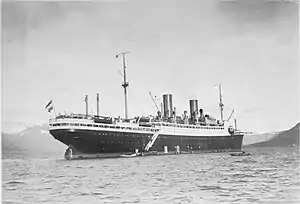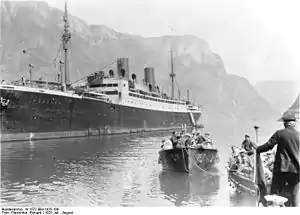SS General von Steuben
SS General von Steuben was a German passenger liner and later an armed transport ship of the German Navy that was sunk during World War II. She was launched as München (sometimes spelled Muenchen), renamed in 1930 General von Steuben (after the famous German officer of the American Revolutionary War), and renamed Steuben in 1938.
 SS General von Steuben | |
| History | |
|---|---|
| Name: |
|
| Namesake: | Friedrich Wilhelm von Steuben |
| Owner: | Norddeutscher Lloyd |
| Builder: | AG Vulcan Stettin, Germany |
| Launched: | 1922 |
| Maiden voyage: | 23 June 1923 |
| In service: | 23 June 1923 |
| Out of service: | 10 February 1945 |
| Renamed: | 1930 |
| Fate: | Sunk, 10 February 1945 |
| General characteristics | |
| Type: | Passenger ship |
| Tonnage: | 14,660 Gross Register Tons |
| Length: | 168 m |
| Beam: | 19.8 m |
| Decks: | 6 |
| Propulsion: | Steam reciprocating, exhaust turbine, twin propellers |
| Speed: | 16 knots |
| Capacity: | 793 (214 cabin class, 358 tourist class, 221 third class) |
During World War II, she served as a troop accommodation ship, and from 1944 as an armed transport. On 10 February 1945 the ship was torpedoed by the Soviet submarine S-13 during Operation Hannibal and sunk. It has been estimated there were around 4,000 deaths.
Early history

In 1923, München was the first German trans-Atlantic passenger liner both to be launched, and to enter New York Harbor, since the end of World War I. She arrived in July 1923 on her maiden trans-Atlantic voyage.[1]
1930 fire and sinking
On 11 February 1930, after docking and discharging passengers and most of her crew from a voyage from Bremen, Germany, a fire broke out in a paint locker which quickly spread to another storage hold; the massive fire and explosion resulting in a five-alarm fire with all fire equipment in New York City being sent to the burning ship. The fire could not be controlled and the ship sank next to the wharf where it had docked.[1]
In one of the largest shipping salvage efforts of its time, München was raised, towed to a dry dock, repaired, and returned to service.[2] Shortly afterwards, the ship's owner renamed her General von Steuben.[3]
World War II
She was commissioned in 1939 as a Kriegsmarine accommodation ship. In 1944, she was pressed into service as an armed transport ship, taking German troops to eastern Baltic ports and returning wounded troops to Kiel.
Operation Hannibal
Along with the Wilhelm Gustloff and many other vessels, she was part of the largest evacuation by sea in modern times. This evacuation surpassed the British retreat at Dunkirk in both the size of the operation and the number of people evacuated.
By early January 1945, Grossadmiral Karl Dönitz realized that Germany was soon to be defeated. Wishing to save his submariners, he radioed a coded message on 23 January 1945 to the Baltic Sea port Gotenhafen (the Polish city and port of Gdynia under German occupation) to evacuate to the West under the code name Operation Hannibal.
Submariners were then schooled and housed in ships lying in the Baltic ports, with most of them at Gotenhafen. Among them were Deutschland, Hamburg, Hansa, and Wilhelm Gustloff.
Notwithstanding the losses suffered during the operation, the fact remains that over two million people were evacuated ahead of the Red Army's advance into East Prussia and Danzig (now Gdańsk, Poland).
In the winter of 1945, East Prussian refugees headed west, away from the city of Königsberg and ahead of the Soviet advance into the Baltic States and East Prussia. Thousands fled to the Baltic seaport at Pillau (now Baltiysk, Russia), hoping to board ships that would carry them to the relative safety of Western Germany. Steuben was in the fleet of ships sent for the purpose.
Final voyage
On 9 February 1945, the 14,660-ton liner sailed from Pillau, near Königsberg, on the Baltic coast for Swinemünde (now Świnoujście, Poland). It was officially reported that there were 2,800 wounded German soldiers; 800 civilians; 100 returning soldiers; 270 navy medical personnel (including doctors, nurses and auxiliaries); 12 nurses from Pillau; 64 crew for the ship's anti-aircraft guns, 61 naval personnel, radio operators, signal men, machine operators and administrators, plus 160 merchant navy crewmen: a total of 4,267 people on board.[4] Due to the rapid evacuation ahead of the Red Army's advance, many Eastern German and Baltic refugees boarded the Steuben without being recorded putting the total number of those on board at around 5,200.
Just before midnight on 9 February, the captain of the Soviet submarine S-13, Alexander Marinesko fired two torpedoes with a 14-second interval; both torpedoes hit Steuben in the starboard bow, just below the bridge, where many of the crew were sleeping. Most were killed by the impact of the torpedoes. According to survivors, she sank by the bow and listed severely to starboard before taking her final plunge within about 20 minutes of the impact of the torpedoes. An estimated 4,500 people died in the sinking. Thanks to the torpedo boat T-196, which hastily pulled up beside Steuben as she sank, about 300 survivors were pulled straight from Steuben's slanting decks and brought to Kolberg in Pomerania (today Kołobrzeg, Poland). A total of 650 people were rescued.
Wreck

The wreck was found and identified in May 2004 by Polish Navy hydrographical vessel ORP Arctowski. Pictures and graphics appear in a 2005 article in National Geographic.[5]
The wreck lies on her port side at about 70 metres (230 ft) depth, and the hull reaches up to 50 metres (160 ft) depth. The ship is mainly intact.
See also
Footnotes
- "New York City, NY (Hudson River) Liner MUENCHEN Fire" Associated Press, 11 February 1930
- "The Ship That Came Back To Life" Popular Mechanics, June 1930
- Grooss, Poul (30 April 2017). The Naval War in the Baltic 1939 -1945. Seaforth Publishing. p. 473. ISBN 9781526700025. Retrieved 23 February 2018.
- Koburger, Charles W., Steel Ships, Iron Crosses, and Refugees, Praeger Publishers, NY, 1989, p.7. Koburger also notes that other equally reliable sources put the total embarked at 3,300.
- Marcin Jamkowski [author] & Christoph Gerigk [photographer], (2005, February), Ghost ship found, National Geographic 207(2), 32–51. See note in the "References" section.
References
- brief data sheet on the Dampfschiff General von Steuben
- National Geographic story National Geographic Magazine, February, 2005, Marcin Jamkowski
- Williams, David, Wartime Disasters at Sea, Patrick Stephens Ltd., Nr Yeovil, UK, 1997, p. 228.
External links
| Wikimedia Commons has media related to Steuben (ship, 1923). |